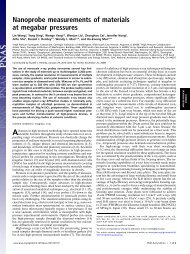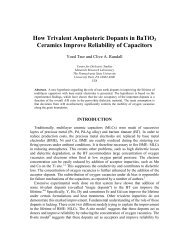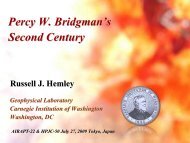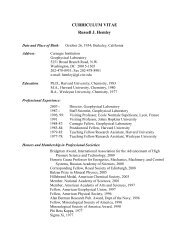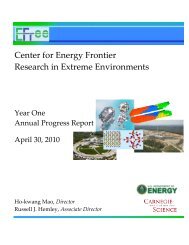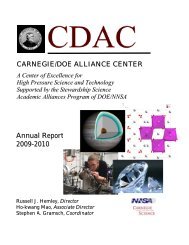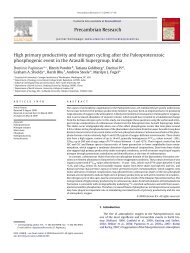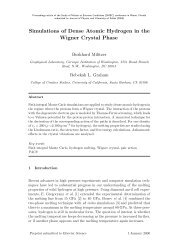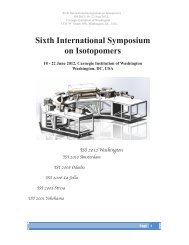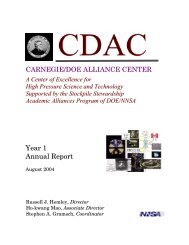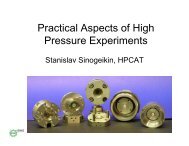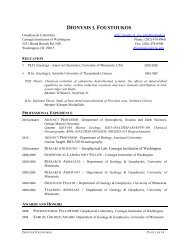Single-Crystal Diamond: - Geophysical Laboratory
Single-Crystal Diamond: - Geophysical Laboratory
Single-Crystal Diamond: - Geophysical Laboratory
You also want an ePaper? Increase the reach of your titles
YUMPU automatically turns print PDFs into web optimized ePapers that Google loves.
<strong>Single</strong>-<strong>Crystal</strong> <strong>Diamond</strong>:<br />
NEW DEVELOPMENTS<br />
AND APPLICATIONS<br />
Russell J. Hemley<br />
<strong>Geophysical</strong> <strong>Laboratory</strong><br />
Carnegie Institution of Washington<br />
Washington, DC<br />
AIRAPT-23 International Conference<br />
Mumbai, India, Sept. 27, 2011
<strong>Diamond</strong> and India<br />
KOH-I-NOR<br />
From Mogul<br />
Dynasty to<br />
the British<br />
Crown<br />
The earliest known reference to diamond is a<br />
Sanskrit manuscript, the Arthasastra ("The<br />
Lesson of Profit") by Kautiliya, a minister of the<br />
Mauryan dynasty in 320-296 BCE:<br />
“A diamond that is big, heavy, capable of bearing<br />
blows, with symmetrical points, capable of<br />
scratching from the inside a glass vessel filled<br />
with water, revolving like a spindle and brilliantly<br />
shining is excellent."<br />
HOPE<br />
From<br />
Golconda,<br />
India to<br />
Washington<br />
D.C.<br />
2
<strong>Diamond</strong> Properties: Early Measurements<br />
<strong>Diamond</strong> has the lowest<br />
compressibility of any known<br />
substance …intimately related<br />
to its low expansion coefficient<br />
and its high atomic<br />
frequency..<br />
L. H. Adams, Compressibility of<br />
<strong>Diamond</strong>, J. Wash. Acad. Sci. 11,<br />
45 (1921).<br />
C. Ramaswamy,<br />
“Raman Effect in<br />
<strong>Diamond</strong>, Nature.<br />
Wash. Acad. Sci.<br />
125, 704 (1921).
<strong>Diamond</strong> Physical Properties are Unique<br />
SINGLE CRYSTAL<br />
DIAMOND<br />
• High hardness/strength<br />
• Transparency<br />
• Low friction<br />
• Low adhesion<br />
• High thermal conductivity<br />
• Low thermal expansion<br />
• High refractive index<br />
• Chemical inertness<br />
• Biocompatibility<br />
• Radiation hardness<br />
• Electrical insulator<br />
• Electronic properties
The Rich<br />
Polymorphism<br />
of Carbon<br />
Predicted<br />
[Hemley,<br />
Crabtree<br />
& Buchanan,<br />
Physics Today<br />
(2009)]
OUTLINE<br />
1. Introduction<br />
2. <strong>Diamond</strong> Synthesis<br />
3. Enhancing Properties<br />
4. Applications<br />
5. Outlook and Perspectives
There is a need to expand current high-pressure<br />
technology to tackle a broad range of new problems<br />
H 2<br />
[Ichimura, Phys. Rep. (1995)]<br />
Carnegie Institution
There is a need to expand current high-pressure<br />
technology to tackle a broad range of new problems<br />
• Reach higher pressures (e.g., 1 TPa range) and<br />
temperatures (>1 eV)<br />
• Larger sample volumes needed (neutron, x-ray<br />
inelastic scattering, THz spectra, NMR)<br />
• Further improve accuracy/precision applications<br />
of multiple simultaneous measurements<br />
Ø Not available nature: dan we synthesize<br />
the needed material?<br />
CVD homoepitaxial growth<br />
1.7mm<br />
3.5mm<br />
7.5mm<br />
16.2mm<br />
0.025 ct 0.25 ct 2.5 ct 25 ct<br />
Carnegie Institution
Synthesis of <strong>Diamond</strong><br />
High-pressure, high-temperature (HPHT) synthesis<br />
HPHT Synthesis of<br />
<strong>Diamond</strong> at General<br />
Electric, Co. (1954); 5-6<br />
GPa, >1000 K, catalysts<br />
HPHT <strong>Diamond</strong> Anvils<br />
• Ultrahigh purity possible<br />
• Sizes to
Synthesis of <strong>Diamond</strong><br />
Low-pressure, metastable synthesis:<br />
chemical vapor deposition (CVD)<br />
• Begun in early 1980’s<br />
• Polycrystalline films<br />
• Growth rates ~1 µm/hr<br />
CVD diamond is synthesized in metastable temperature and pressure<br />
conditions. Atomic hydrogen is key to diamond deposition.<br />
Microwaves<br />
H 2 + CH 4<br />
• Co-deposition (sp 2 , sp 3 )<br />
• Etching (sp 2 , sp 3 )<br />
H 2<br />
e-, Δ <br />
CH 4 + H CH 3 + H 2<br />
2 H<br />
CVD diamond<br />
Plasma is created<br />
H<br />
DIFFUSION<br />
H<br />
H<br />
substrate<br />
T s = 800 – 1000 o C<br />
10 10
CVD techniques have enabled new diamond technology<br />
<strong>Diamond</strong> Growing in a Plasma Reactor<br />
Microwave Plasma CVD:<br />
100-200 torr H 2 pressures<br />
[Yan et al., Proc. Nat. Acad. Sci. (2002)]<br />
“Designer Anvils”<br />
[Vohra & Weir, High<br />
Pressure Phen. (2002)]<br />
Production of regular<br />
diamond anvil<br />
• 2.45 mm high<br />
• 0.28 carats<br />
• Grown in 1 day<br />
[Yan et al. Phys. Stat. Sol. (2004)]<br />
[Ho et al., Industrial<br />
<strong>Diamond</strong> Rev. (2006)]<br />
Half-inch single crystal
High-pressure/high-temperature (HPHT) annealing<br />
can enhance optical properties and hardness<br />
• Colored CVD<br />
diamonds made<br />
transparent<br />
• Introduce new<br />
colors<br />
[Charles et al.,<br />
Phys. Stat. Sol. (2004)]<br />
[Yan et al. Phys. Stat. Sol. (2004)] Carnegie Institution
[Meng et al., Proc. Nat. Acad. Sci. (2008)]<br />
Carnegie Institution
Boron-doping of single crystal CVD<br />
diamond at high growth rates<br />
• Solid h-BN introduced<br />
into plasma (B, N codoping)<br />
4 ppm boron<br />
• Boron content from<br />
SIMS and IR spectra<br />
UV-Visible Spectra<br />
Synchrotron Infrared Spectra<br />
[Liang et al., J. Phys.: Condens. Matter (2009)]<br />
Carnegie Institution
There is a significant drop in N-V center<br />
luminescence of the B-boron doped diamond<br />
[Liang et al., J. Phys.: Condens. Matter (2009)]<br />
Carnegie Institution
Fracture toughness is dramatically enhanced<br />
by annealing and B-,N- codoping<br />
• Low-P, high-T annealing can improve SC-CVD diamond<br />
hardness by 50% without reducing fracture toughness<br />
• Boron/nitrogen co-doping can greatly increase fracture toughness<br />
Carnegie Institution
Different MPCVD reactors<br />
are used and being<br />
developed<br />
2.45 GHz, 5-8 kW<br />
Modified Seki AX5400, AX6500<br />
2.45 GHz,<br />
10-15 kW<br />
New Design<br />
915 MHz, 75 kW<br />
Seki AX6600<br />
Multiple diamond growth (>100 pieces)!<br />
and large diamond!<br />
Cross section Electric field<br />
of CVD distribution<br />
chamber<br />
[Hemawan et al., in preparation]
Cutting/<br />
Shaping<br />
Anvils<br />
l<br />
l<br />
l<br />
l<br />
Q-switched Nd:YAG Laser; robotic XYZ stage<br />
Rough diamond to 1 carat anvil in under an hour<br />
Final mechanical polishing/etching/annealing<br />
Sputtering/focused ion beam/fine laser cutting
Anvil surface characterization is essential<br />
for enhanced high P-T performance<br />
[Krasnicki et al.,<br />
to be published]<br />
As measured by profilometer<br />
Three-dimensional view<br />
of culet segment<br />
Polished/etched in-house<br />
Commercial polish<br />
Nanometer smoothness<br />
of carefully polished/etched<br />
diamond<br />
Zygo New View<br />
optical profilometer<br />
Carnegie Institution
Carnegie Institution
CVD single-crystal<br />
diamond anvils<br />
[Meng et al., NDNC (2009)]<br />
2.3 carat<br />
0.3 carat<br />
Carnegie Institution
Large high-purity CVD single crystal<br />
anvils are being produced<br />
[Meng et al., Phys. Status<br />
Solidi. A, in press]<br />
High-purity CVD single-crystal material<br />
has been grown at high growth rates<br />
(around 50 µm/h) in the absence of<br />
impurities (other than hydrogen)<br />
Transmittance<br />
1.0<br />
0.8<br />
0.6<br />
0.4<br />
0.2<br />
0.0<br />
This material has high optical quality and<br />
clarity without visible growth interface<br />
UV-VIS transmission<br />
high-purity CVD plate (0.5 mm)<br />
2.4 ct high-purity CVD anvil (4 mm)<br />
400 500 600 700 800<br />
Wavelength (nm)<br />
Second order Raman<br />
Intensity (normalized to diamond peak)<br />
1.0<br />
0.8<br />
0.6<br />
0.4<br />
0.2<br />
0.0<br />
Raman/Photolum<br />
First order Raman<br />
First order Raman<br />
Second order Raman<br />
480 540 600<br />
Wavelength (nm)<br />
Cathodoluminescence<br />
12000<br />
Raman scattering intensity<br />
10000<br />
8000<br />
6000<br />
4000<br />
2000<br />
CVD homoepitaxial growth<br />
0<br />
2100 2400 2700<br />
1.7mm<br />
3.5mm<br />
7.5mm<br />
Raman shift (cm -1 )<br />
16.2mm<br />
Quality factor = 5<br />
0.025 ct 0.25 ct 2.5 ct 25 ct<br />
Carnegie Institution
Spectroscopic characterization reveals origin of residual<br />
color and ways to further improve optical quality<br />
Photoluminescence<br />
Mapping<br />
Cathodoluminescence<br />
PL Intensity (normalized to diamond peak)<br />
2.0<br />
1.8<br />
1.6<br />
1.4<br />
1.2<br />
1.0<br />
0.8<br />
0.6<br />
0.4<br />
0.2<br />
0.0<br />
First order Raman<br />
Second order Raman<br />
NV center<br />
480 540 600<br />
Wavelength (nm)<br />
Excited by 457nm laser<br />
Measuring from culet to girdle<br />
The color due to unintentional<br />
leak of nitrogen<br />
Carnegie Institution
High-purity electronic grade<br />
diamond can now be produced<br />
[Meng et al., in preparation]<br />
1<br />
Relative Intensity<br />
0.8<br />
0.6<br />
0.4<br />
0.2<br />
Quality factor QF = (F-B)/(R-B)<br />
B - Background<br />
Intensity<br />
1600<br />
1400<br />
1200<br />
1000<br />
800<br />
600<br />
400<br />
200<br />
0<br />
1800 2000 2200 2400 2600 2800<br />
Wavenumber (cm -1 )<br />
514.532<br />
B<br />
F<br />
R<br />
Raman scattering intensity<br />
0<br />
0 1000 2000 3000 4000 5000 6000 7000<br />
12500<br />
Wavenumber (cm -1 )<br />
10000<br />
7500<br />
5000<br />
2500<br />
QF = 0.04<br />
0<br />
1800 2000 2200 2400 2600 2800 3000<br />
Raman shift (cm -1 )<br />
Carnegie Institution
16.2mm<br />
1.6mm<br />
10.7mm<br />
Reaching megabar and multimegabar pressures<br />
<strong>Single</strong>-crystal CVD anvils<br />
can generate multimegabar<br />
B<br />
pressures<br />
2.8mmA<br />
[W. Mao et al.,<br />
Appl. Phys.<br />
Lett. (2003)]<br />
seed<br />
CVD homoepitaxial growth<br />
G<br />
12.1mm<br />
H<br />
B<br />
9°<br />
!<br />
Composite<br />
anvil polishing<br />
As-grown CVD anvil<br />
[Zha et al., High Pres. Res. (2009)]<br />
Final polishing<br />
double bevel<br />
Carnegie Institution
Next generation anvil technology: large and small<br />
• <strong>Single</strong> <strong>Crystal</strong> <strong>Diamond</strong> Belt Apparatus<br />
[Boehler and Guthrie,to be published]<br />
• Nanomachining<br />
intelligent devices<br />
[Matsui, to be published]<br />
• Laser machining<br />
• Focused ion beams<br />
• Lithography<br />
[Struzhkin et al., to be published]
Next generation high-pressure devices<br />
with larger sample volume<br />
[Strobel et al.,<br />
in preparation]<br />
NEUTRON SCATTERING<br />
Spallation Neutron Source (SNS)<br />
<br />
D 2 :D 2 O, C 1<br />
(1 GPa, RT)<br />
0.08mm 3<br />
He: ice II<br />
structure R-3<br />
[Londono et<br />
al. Nature 332,<br />
141 (1988)]<br />
SNAP<br />
INSTRUMENT<br />
• A volume reduction of 1,000 relative to<br />
conventional cells (SNS flux)<br />
• On a path for increasing sample volume<br />
with larger, high-strength anvils
<strong>Single</strong>-crystal CVD diamond is an excellent window<br />
for small-angle x-ray scattering (SAXS)<br />
Diameter: 3.0 mm, Thickness: 0.5 mm<br />
The lack of strong cross-shaped scattering and large<br />
dimensions makes CVD diamond promising for high-pressure SAXS<br />
[Meng, Ando, Wang, Gruner<br />
et al., to be published]
Origin of high quality CVD diamond<br />
SAXS windows and test results<br />
[Meng, Ando, Wang, Gruner<br />
et al., to be published]<br />
{004} projection topography of CVD diamond <br />
Diameter: 3.0 mm, Thickness: 0.5 mm<br />
<br />
<br />
<br />
Tests: SAXS spectra of T4<br />
lysozyme mutants during<br />
pressure-induced folding<br />
and unfolding<br />
CVD diamond with nitrogen<br />
has stronger SAXS scattering<br />
!
These techniques are needed to understand the molecular<br />
basis of microbial viability at very high pressures<br />
E. coli viability at 2.5 GPa<br />
[after Bartlett, Sloan Workshop (2008)]<br />
Morphology changes<br />
in pressurized E. coli<br />
from 1 GPa<br />
[Griffin et al.,<br />
to be published]<br />
[Sharma et al., to be published]<br />
Development of new diamondwindowed<br />
high-pressure apparatus<br />
for biology and soft matter
Optically Detected Magnetic Resonance<br />
[Struzhkin et al.,<br />
to be published]<br />
3.4<br />
Pressure dependence <br />
of the ODMR transi9on <br />
First high pressure experiment<br />
3.3<br />
NaCl<br />
Ne<br />
NV -<br />
29 GPa<br />
Frequency (GHz)<br />
3.2<br />
3.1<br />
3.0<br />
2.9<br />
0 10 20 30<br />
Pressure (GPa)
Extending measurements of superconductivity<br />
<br />
<br />
<br />
<br />
<br />
<br />
<br />
<br />
<br />
<br />
3<br />
1<br />
2<br />
3 1 2<br />
[Chen et al., Nature (2009)]
Prospects for magnetic<br />
sensing with NV - centers<br />
PREDICTED SUPERCONDUCTING/<br />
SUPERFLUID METALLIC HYDROGEN<br />
[Babaev et al., Phys. Refv. Lett. (2005)]<br />
NV -<br />
• ODMR NVmapping<br />
with<br />
pressure<br />
• Compression of<br />
nano-diamonds with<br />
single NV - centers –<br />
detection of small<br />
samples in DACs<br />
• Magnetic mapping using ensembles of NV -<br />
centers in DACs under pressure vortices, flux<br />
lines, domains on micron scales<br />
[Nature Nanotechnology, v.6, 358–363, 2011]<br />
Insert
Catalyst-free high P-T synthesis<br />
of nanopolycrystalline diamond <br />
New form of carbon:<br />
mesoporous diamond <br />
[Zhang et al., Proc. Nat. Acad. Sci. (2010)]<br />
Polynanocrystalline <strong>Diamond</strong><br />
(Ehime Univ.) <br />
[Nakamoto et al., Rev. Sci. Instrum. (2011)]<br />
Polycrystalline graphite transforms <br />
to superhard nanopolycrystalline <br />
diamond at 20 GPa and 2300 °C. <br />
The technique has been extended <br />
to create mesoporous forms. <br />
TEM image reveal a<br />
mesostructure in the diamond
New transformation in sp 3<br />
carbon – ‘amorphous diamond’<br />
[Lin et al., Phys. Rev., Lett., in press] <br />
• Conversion of glassy sp 2 carbon to<br />
all sp 3 carbon<br />
• No glassy carbon observed above 45 GPa<br />
• Reversible transformation
Probing carbon in new P-T regimes<br />
[Smith, Eggert, Braun, Jeanloz, Duffy, et al.] <br />
<br />
<br />
<br />
<strong>Diamond</strong> to 5 TPa <br />
1000<br />
LASER DRIVEN DYNAMIC<br />
COMPRESSION<br />
Distance (pixels)<br />
800<br />
600<br />
400<br />
14<br />
16 18 20<br />
Time (ns)<br />
22ns<br />
• Carbon and other materials at unprecedented compressions<br />
• Equations of state, phase transformations, structures, etc.<br />
Carnegie Institution
iamond is needed for this new generation of static<br />
nd dynamic compression experiments<br />
<br />
<br />
<br />
Combined static/"<br />
dynamic compression"<br />
compression to probe "<br />
ʻcold compressionʼ and"<br />
planetary adiabats"
Applications beyond high-pressure science:<br />
large single crystal diamond in lasers and x-ray optics<br />
X-ray Topography<br />
TILT<br />
Stokes and anti-<br />
Stokes stimulated<br />
Raman spectra of<br />
~670-µm SC-CVD<br />
diamond with<br />
picosecond laser<br />
pumping at 0.532 µm<br />
and 1.064 µm.<br />
STRAIN<br />
[Kaminski et al., Laser Physics Lett. (2007)]<br />
• 400 rocking curves: 0.006º,<br />
(0.003º theoretical limit)<br />
• Separation of tilt and strain<br />
[Krasnicki et al., to be published] 380 µm<br />
X-ray lenses have been<br />
fabricated from<br />
polycrystalline CVD<br />
diamond. <strong>Single</strong> crystal<br />
material is needed for<br />
improved optical and<br />
mechanical properties.<br />
[Evans-Lutterrodt &<br />
Isakovic, to be published]
There are numerous other applications<br />
of single crystal diamond<br />
Tribological surfaces<br />
- bearing linings<br />
Electro-optical devices<br />
- field emitters<br />
Semiconductors<br />
- electrodes<br />
Thermal management<br />
- heat sinks/spreaders<br />
Optical gates<br />
- x-ray windows<br />
Acoustic vibrators<br />
- SAW filters<br />
Dielectric media<br />
- capacitor interlayer<br />
Nuclear detectors<br />
- particle sensors<br />
Chemical barriers<br />
- acid containers<br />
Precision cutting<br />
- nanomachining<br />
Non-linear optics<br />
- Raman shifter<br />
Fusion energy<br />
- ITER, NIF<br />
Thick Disk Laser<br />
Nd:GGG >100 kW<br />
>100 million 0 C, 500 MW fusion power.<br />
Mechanically strong low loss<br />
window and injection materials<br />
Microchannel Cooler<br />
Ø Convert from Cu to <strong>Diamond</strong><br />
Ultrastrong nozzles for water jet machinining<br />
Wear resistant wire dies for ultrafine wire production
• What is the nature of carbon<br />
in extreme environments<br />
such as deep in the Earth<br />
• Where is the carbon in the<br />
Earth and how much is there?<br />
• How does carbon move<br />
between reservoirs?<br />
• Is there a deep source of<br />
organics?<br />
• What is the nature and extent<br />
of deep microbial life?<br />
Ø<br />
Ø<br />
Ø<br />
Major international<br />
academic/ government/<br />
industrial collaboration.<br />
Funded by A. P. Sloan<br />
Foundation ($500 M over<br />
10 years).<br />
To join, visit: http://dco.ciw.edu
CONCLUSIONS AND PERSPECTIVES<br />
1. <strong>Diamond</strong> remains a ‘cornerstone’ of research on<br />
materials in extreme environments.<br />
2. Advances in CVD and other synthesis techniques are<br />
creating new kinds of diamond with an expanded<br />
range of physical properties.<br />
3. Applications of the diamond material in high-pressure<br />
research span the physical and biological sciences.<br />
4. New phases and transformations of carbon continue<br />
to be uncovered.<br />
5. Future prospects are bright with the development of<br />
new technology and new international programs.
ACKNOWLEDGEMENTS<br />
Collaborators<br />
CARNEGIE INSTITUTION<br />
Ho-kwang Mao Alexander Goncharov<br />
Timothy Strobel M. Somayazulu<br />
Viktor Struzhkin Ronald E. Cohen<br />
N. Subramanian Muhetaer Aihaiti<br />
Chih-shue Yan Changsheng Zha<br />
Reini Boehler Yufei Meng<br />
Yingwei Fei<br />
Stephen Gramsch<br />
Jinfu Shu<br />
Qi Liang<br />
Zhenxian Liu Yufei Meng<br />
Guoyin Shen Yue Meng<br />
Jerry Potter<br />
Carnegie Institution<br />
Financial Support<br />
DOE/NNSA, DOE/OS/BES,<br />
NSF, A. P. Sloan Foundation<br />
Carnegie Institution<br />
Deep<br />
Carbon<br />
Observatory<br />
OTHER INSTITUTIONS<br />
Amy Lazicki (Livermore)<br />
K. Litasov (Tohoku)<br />
Jon Eggert (LLNL)<br />
Rip Collins (LLNL)<br />
S. Gruner (Cornell)<br />
S. Ando (Cornell)<br />
E. Gregoryanz (Edinburgh)<br />
Y. Lin (Stanford)<br />
Wendy Mao (Stanford)<br />
Yusheng Zhao (LANL)<br />
Peter Lazor (Uppsala)<br />
Anurag Sharma (Boston)<br />
Adrienne Kish (Orleans)<br />
Burkhard Militzer (UCB)<br />
Neil Ashcroft (Cornell)<br />
Roald Hoffman (Cornell)
Carnegie Institution<br />
Thank you!



